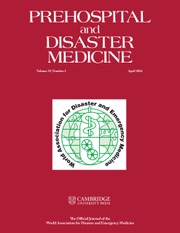How the Understated Role of Rehabilitation Within Emergency Responses Can Be Addressed: A Call to Action from the IFRC Technical Working Group
Published online by Cambridge University Press: 21 May 2025
Abstract
The role of rehabilitation in EMTs remains unclear. Due to this and reasons related to inadequate initial planning, the role of rehabilitation professions in emergencies is understated. Further, there is no one-size-fits-all approach to rehabilitation in emergencies.
The IFRC Rehabilitation Technical Working Group proposes solutions to address these challenges.
There are three main challenges for EMTs to deliver rehabilitation in emergency settings. Firstly, a universal definition of ‘rehabilitation’ remains absent. Secondly, advocacy to integrate rehabilitation into EMTs is often not enough to ensure success. Thirdly, various rehabilitation needs may not match current offerings in EMTs.
First, ‘rehabilitation’ must be defined based on its impact, interventions, and goals to encompass both specialized services and services integrated into the wider health system and a universal definition which creates wider understanding must follow. Second, the end recipients of rehabilitation service delivery prior, during or following emergencies, should be clearly accounted for at the outset of emergencies. Planning exit strategies post-emergencies involves choosing the appropriate iteration of rehabilitation in the local context that is socially acceptable and sustainable. Examples include modularization of rehabilitation services outside of traditional field hospitals, and extending services beyond traditional time frames.
The role of rehabilitation in EMTs is often overlooked due to three key challenges which may be addressed through clearly defining rehabilitation and its role in EMTs, adequately preparing for sustainable post-emergency rehabilitation handovers in local contexts and creating and delivering various rehabilitation offerings within EMTs. Research should explore the effect of these potential solutions in emergency settings.
Information
- Type
- Meeting Abstracts
- Information
- Copyright
- © The Author(s), 2025. Published by Cambridge University Press on behalf of World Association for Disaster and Emergency Medicine
Footnotes
Abstract updated 18 June 2025.


